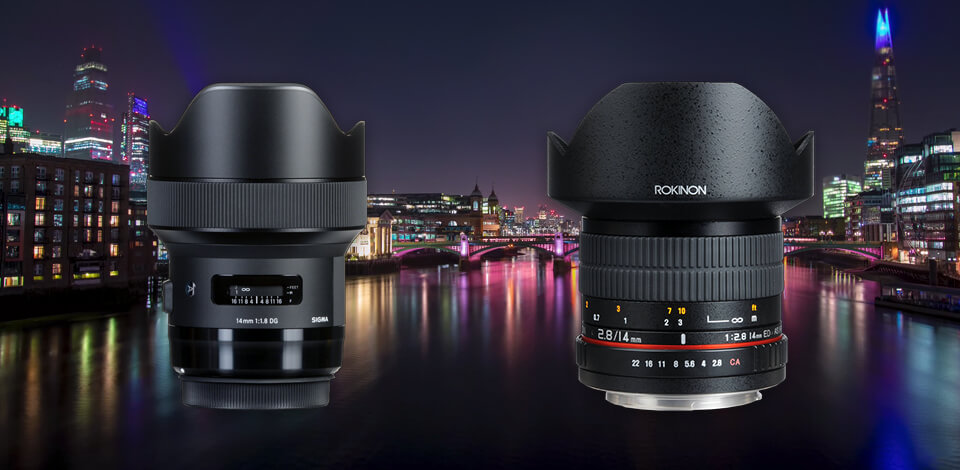
I’ve spent years taking pictures at night: city lights, star-filled skies, quiet forests, and even portraits in the dark. During this time, I realized that not all lenses for night photography work well in low light.
Shooting at night is tough on both the camera (for example, autofocus and light-gathering ability) and the lens, so choosing the right one makes a big difference. Lenses that work best at night usually have a wide aperture (between f/1.2 and f/2.8), stay sharp across the whole frame, and almost don’t have chromatic aberration, even when used at their widest setting.
 ★★★★★ (5/5)
★★★★★ (5/5)
After trying many options, I believe that the Sigma 85mm f/1.4 DG HSM Art is the top lens for night photography. It is very sharp, avoids light streak problems, and has a fast aperture, making it great for night shoots.
When I shared some of my night photos online, people started asking me which lenses I recommend. That’s when I decided to do a full test and compare different lenses for night photography. I worked with my colleagues from the FixThePhoto team to test 50+ lenses for night photography in real low-light situations to see which ones worked best.
Of course, having the right night photography lens is important, but it’s not the only thing that’s important. I’ve put together a list of must-have items that always help capture sharper, clearer night photos, no matter if I’m in a busy city or out in the forest. Here’s what I always carry:
Amazon: 200+ bought in past month
B&H: 3K+ sold in the past year
Adorama: 2K+ sold in the past year

I’ve been using the Sigma 85mm f/1.4 Art lens for a few years now, and it’s one I keep going back to. This night photography lens is especially good when I take portraits at night. I like how it makes the background look soft and blurred while keeping the person in focus, even when the light is low.
One of my favorite times using it was at a rooftop café during blue hour. The streetlights below turned into soft glowing circles, while my friend, whom I was photographing, stayed perfectly sharp, even when I used it at its widest aperture. I’ve taken portraits lit only by candles, sparklers, and neon signs, and the details always stay clear.
I even tried it on nighttime landscapes, which isn’t what an 85mm is usually used for, and it delivered astonishing results. From the other side of a lake, it captured treetops and reflections in the water with very high clarity, especially when I put the camera on a tripod and used mirror lockup.
The one downside is the size. This Sigma lens is big, heavy at the front, and takes up a lot of space in my bag. But once I start shooting, I kind of get used to the weight, so it’s not that big of a deal. The sharpness, contrast, and smooth background blur make carrying the extra weight worth it.
Amazon: 150+ bought in past month
B&H: 2K+ sold in the past year
Adorama: 1.5K+ sold in the past year
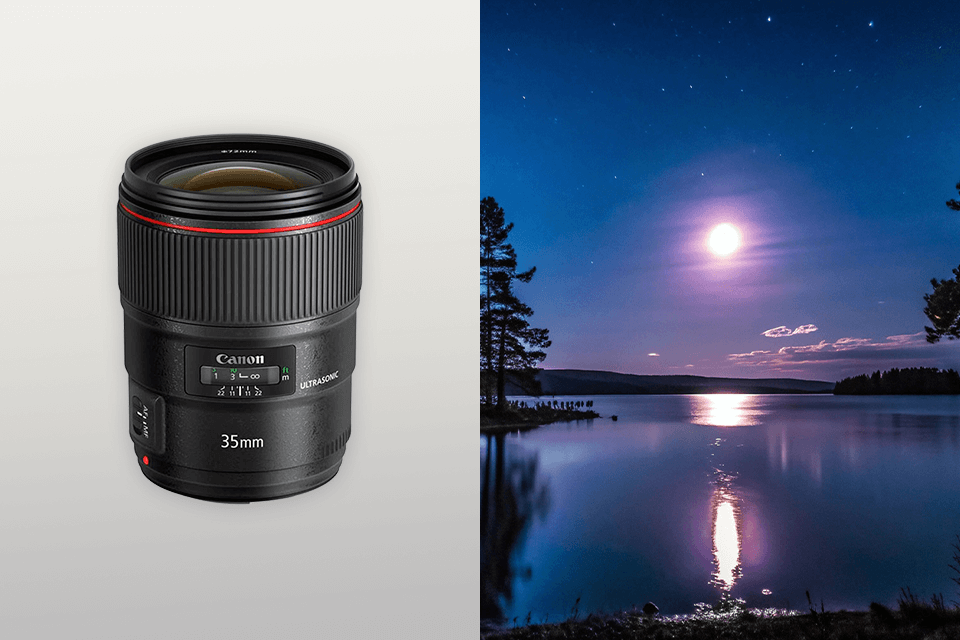
This Canon lens quickly became a favorite for the whole team. I used it for a night shoot in the old part of the city, where the only light came from street lamps, and the way it handled both the bright lights and the dark shadows was very impressive. I didn’t even need a flash: the wide f/1.4 aperture let in enough light to keep ISO low, so my photos stayed clean even when shooting handheld.
I also took this night photo lens into the woods just after sunset once. I used it for silhouettes and portraits with the last bit of natural twilight. The autofocus was quick and accurate, even though it was almost dark, which doesn’t always happen with lenses that are this fast.
I even took a candid picture of my model lighting a sparkler. The lens locked focus immediately, and that shot ended up being one of my favorites from the whole test. It was also sharp across the frame, even at its widest aperture.
Another thing I liked was how durable it is. One evening, it started raining lightly while we were shooting near a river, but I didn’t worry at all. The lens is well-sealed, so there was no fogging, and it worked perfectly. Also, the hood helped block glare from nearby streetlights. It’s the kind of lens I’d trust for important projects, no matter what the weather or lighting conditions are like.
Amazon: 2K+ bought in past month
B&H: 30K+ sold in the past year
Adorama: 20K+ sold in the past year
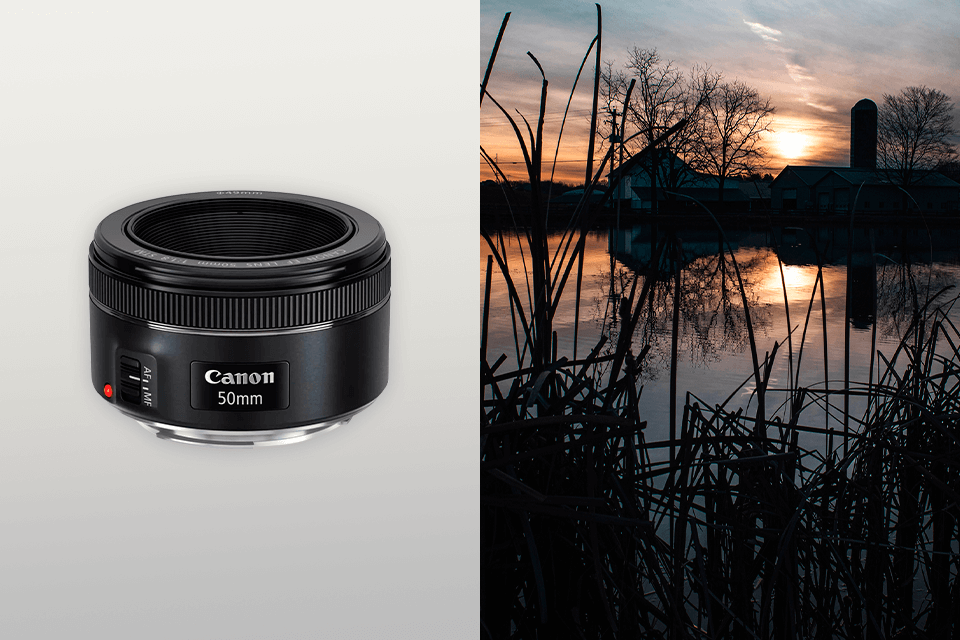
I bought this 50mm lens just because I was curious. It’s very cheap, and since it had thousands of good reviews on Amazon, I thought it was worth trying for travel and night portraits. I wasn’t expecting much, but after using it during several evening walks around the city, I was surprised. The photos had that smooth, blurry background I usually only see in expensive lenses.
One of my favorite tests was a couple standing under fairy lights outside a café. I shot handheld at f/1.8, without a flash, and the atmosphere came out perfectly.
The only issue is that when used at wide apertures, the edges of the frame aren’t very sharp, especially if I’m photographing a group at night. But I quickly found a solution: keep the main subjects in the center and, if needed, close the aperture slightly to f/2.2. With this adjustment, the photos looked much better. For night street photography or single-person portraits, this lens works just fine.
Another thing I love is its small size. It’s perfect for travel or casual evening shoots when I don’t want to carry a heavy gear bag. It’s so small it can even fit in a jacket pocket. After using large night photography lenses like the Sigma Art series, this little 50mm feels very light and easy to handle.
Amazon: 100+ bought in past month
B&H: 20K+ sold in the past year
Adorama: 10K+ sold in the past year
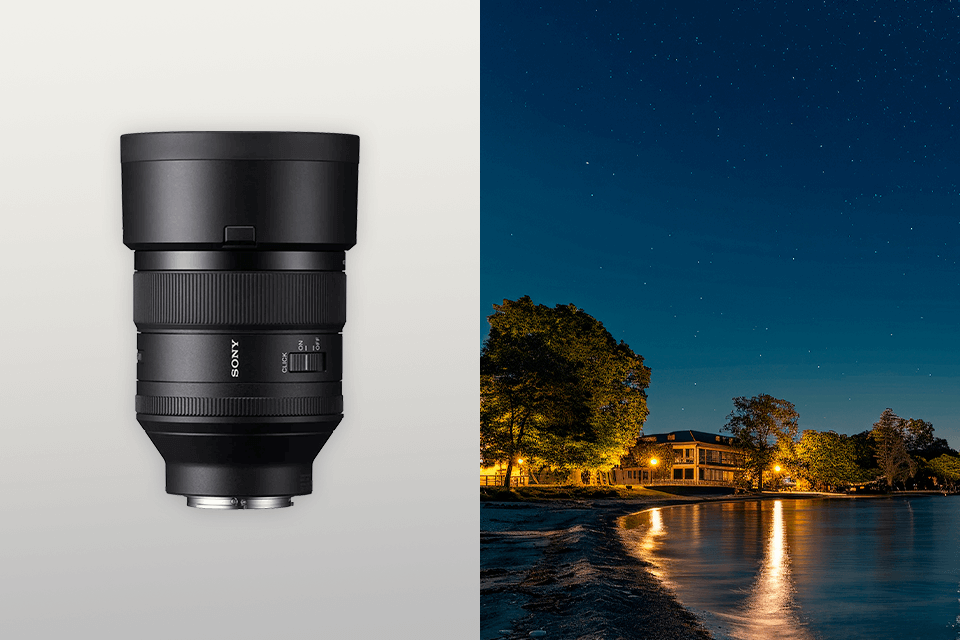
My colleague Robin’s favorite lens is the Sony FE 85mm f/1.4 GM, and after borrowing it for one weekend, I understood why. I’ve used many 85mm lenses before, but this one stands out for how sharp, clear, and beautiful the results are when shooting at night.
During a street photo session in low light, it handled everything: dark alleys, neon signs, backlit portraits. The autofocus was fast and accurate, even when I was shooting wide open at f/1.4. The background blur was especially impressive. I took a portrait of a jazz singer under a single spotlight, and the distracting bar scene behind her turned into a soft swirl of light.
The design of the lens is also very thoughtful. It has an aperture ring that changes in clicks in 1/3-stop increments, two buttons can be set up for your own needs, and strong weather sealing.
The only downside is the weight. When I used it on my smaller Sony a7C, it felt front-heavy, and after long handheld sessions, the balance wasn’t great. This Sony lens works better on bigger cameras for night photography, but the performance and image quality are still outstanding.
Amazon: 200+ bought in past month
B&H: 40K+ sold in the past year
Adorama: 20K+ sold in the past year
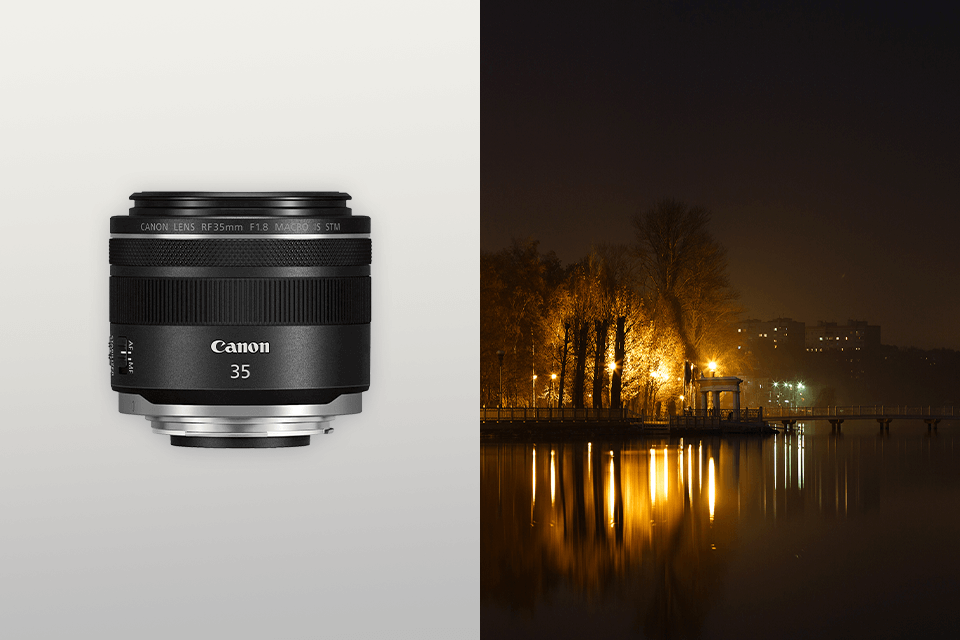
Yep, another Canon on my list. Their lenses really shine when it comes to night photography. I tested the Canon RF35mm f/1.8 IS Macro STM on a night walk through the town to see if I could shoot handheld without a tripod.
Thanks to the wide f/1.8 aperture and built-in image stabilization, I get sharp shots even at 1/8 shutter speed. What impressed me most was its flexibility. In night cafés or bars, when I wanted to highlight details (like desserts on a table or someone’s hands holding a cup), the close-focusing ability was very useful. While it’s not an actual macro lens, it’s good enough for storytelling.
Of course, it has some drawbacks. The plastic mount and very light build don’t feel premium or super professional. Nevertheless, that’s what makes it perfect for travel: this night photography lens is so light you can just throw it in a small bag in case you need it.
Amazon: 300+ bought in past month
B&H: 40K+ sold in the past year
Adorama: 30K+ sold in the past year
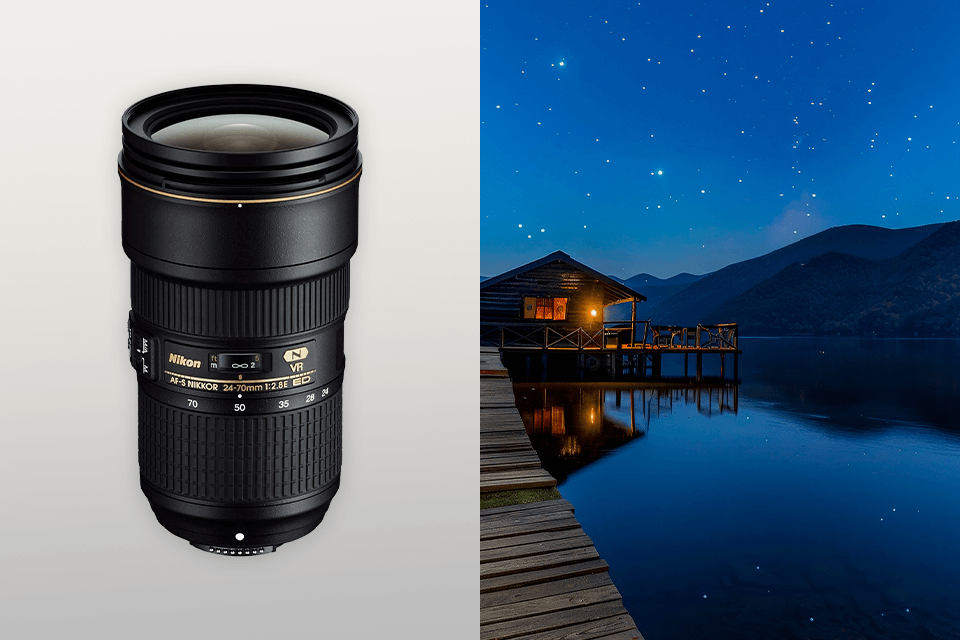
We have the Nikon 24-70mm f/2.8E VR lens in our studio. We mostly use it for events and portraits, but I hadn’t tried it much at night. Since it’s a lens that many professional photographers like, I wanted to see how good this lens is for night photography. The Nikon 24-70mm f/2.8E VR caused some debate when it first came out, so I was curious.
The best thing about it is that it can do a lot. You can take wide shots of a street or zoom in on one person quickly. The pictures look clean and natural, with good colors and contrast. Nikon added special Nano and fluorine coatings to the lens, which help when it’s misty or rainy, and make it easier to clean.
On the downside, this Nikon lens is quite heavy. After walking around and holding it for an hour, my arm got tired. It’s also bigger than the G version, with a large filter size and a long barrel. So, although it works great, it’s not very easy to carry around.
Amazon: 100+ bought in past month
B&H: 20K+ sold in the past year
Adorama: 15K+ sold in the past year
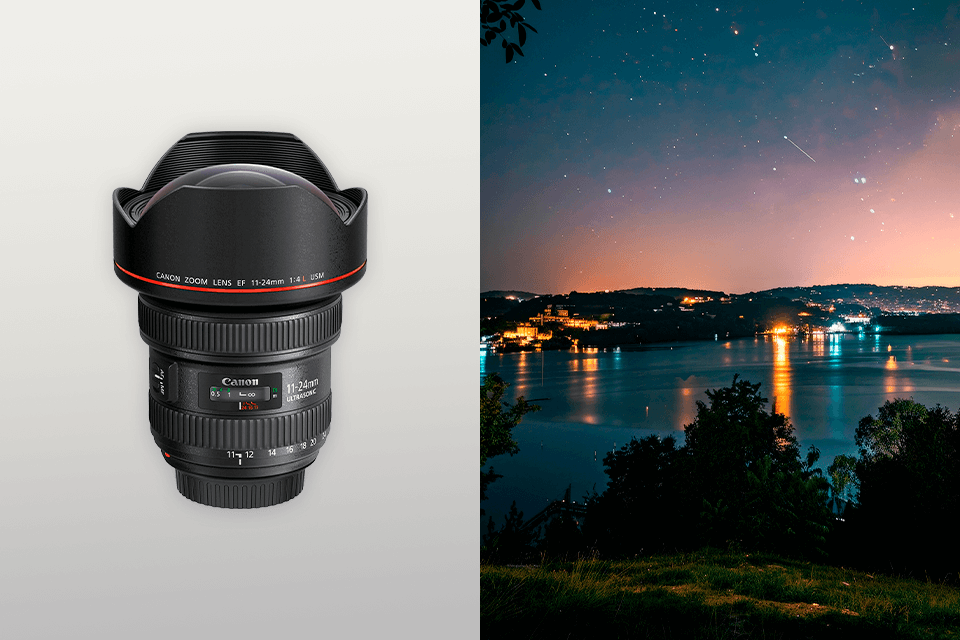
I also tried the Canon EF 11-24mm f/4L USM lens. I liked it a lot because it’s one of the best wide-angle zoom lenses I’ve tested. The sharpness, quality, and performance are excellent. However, it costs a lot, so most night photographers might not buy it unless they also do landscapes, architecture, or indoor photography professionally.
Using this Canon lens at night was fun, especially when using it with a camera for night photography. The autofocus is quiet and works well, the barrel feels strong but light, and the zoom ring moves smoothly.
I also liked that I could get very close to subjects, allowing me to have more options for creative shoots. Even though f/4 is not the brightest, the lens stays sharp across the frame and doesn’t show much coma, which is good for astrophotography, where you can increase exposure time a little.
To make our night photography lens list, we tested each lens during real night shoots. My FixThePhoto team and I mostly took photos of nature, countryside scenes, and some city areas. Full-frame lenses were tested on a Canon EOS R5 or Nikon Z6 II (with an adapter if needed), and smaller APS-C models were tested on a Sony A6700 and Fujifilm X-T5.
I tried to shoot when there was no moon, so I could see how well the lenses handled dark conditions. When testing, I looked at corner sharpness, how bright the lens is, contrast, and checked for coma. For astrophotography, I used manual focus with a zoomed-in live view to check if it was easy to focus on stars.
We also looked at comfort during long shoots in cold weather: weight, handling, how smooth the focus ring was, and if the night photography lens handled mist and humidity well. I often wore gloves, so I also noted if the rings were easy to turn.
Finally, I thought about practical things. Could you put filters on the lens to protect it or reduce light pollution? Was it weather-sealed? Did it fog up? These small details matter a lot when shooting at night, especially in remote places.